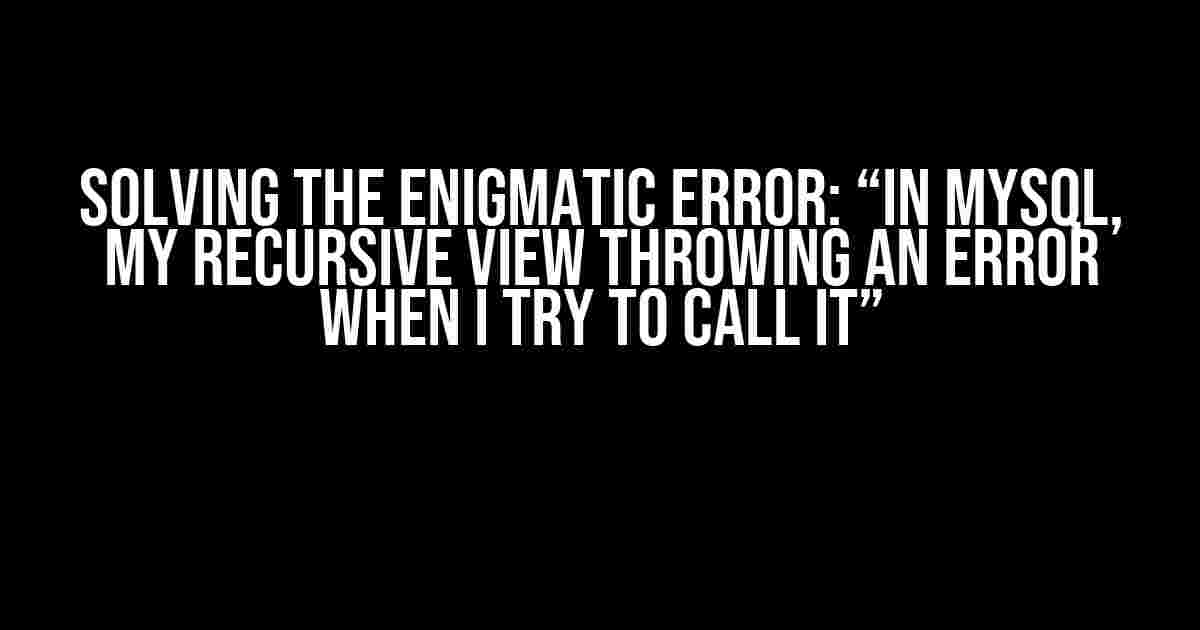Have you ever encountered the frustrating error “In MySQL, My recursive view throwing an error when I try to call it”? You’re not alone! This perplexing issue has plagued many a MySQL developer, leaving them scratching their heads and wondering what went wrong. Fear not, dear reader, for we’re about to embark on a journey to demystify this error and provide a comprehensive guide to resolving it once and for all.
What is a recursive view, and why is it throwing an error?
A recursive view is a type of view in MySQL that references itself, allowing it to perform complex hierarchical or tree-like operations. Recursive views are incredibly powerful, enabling you to tackle tasks that would be impossible or impractical with regular views. However, this power comes at a cost – recursive views can be notoriously finicky, and a small mistake can cause the entire construct to come crashing down.
The error “In MySQL, My recursive view throwing an error when I try to call it” typically occurs when there’s a problem with the recursive view’s definition, usage, or underlying database structure. It’s essential to identify and fix these issues to get your recursive view up and running smoothly.
Common Causes of the Error
Before we dive into the solution, let’s take a closer look at some common causes of the error:
- Infinite recursion: If your recursive view doesn’t have a proper anchor query or termination condition, it can lead to infinite recursion, causing the error.
- Cyclic dependencies: Recursive views can’t reference other views or tables that, in turn, reference the original view, creating a cyclic dependency.
- Self-referential subqueries: Using self-referential subqueries within the recursive view can lead to errors, especially if not properly correlated.
- MySQL version limitations: Older MySQL versions may not support recursive views or have limited functionality.
- Database permissions: Insufficient database permissions can prevent the view from being created or executed.
Step-by-Step Guide to Resolving the Error
Now that we’ve covered the common causes, let’s walk through a step-by-step guide to resolving the error:
Step 1: Review Your Recursive View Definition
Examine your recursive view definition carefully, paying attention to the following:
CREATE VIEW recursive_view AS SELECT ... FROM ... WHERE ... UNION ALL SELECT ... FROM ... WHERE ...;
Check for:
- Proper anchor query and termination condition
- No cyclic dependencies or self-referential subqueries
- Correct syntax and formatting
Step 2: Verify Database Permissions
Ensure that the user account executing the recursive view has the necessary permissions:
GRANT SELECT, EXECUTE ON *.* TO 'username'@'%';
Or, if you’re using a specific database:
GRANT SELECT, EXECUTE ON database_name.* TO 'username'@'%';
Step 3: Upgrade to a Supported MySQL Version
If you’re using an older MySQL version, consider upgrading to a version that supports recursive views (MySQL 8.0 or later):
SELECT @@version;
Check the output to ensure you’re running a supported version.
Step 4: Optimize Your Query
Optimize your recursive view query to reduce the risk of infinite recursion or performance issues:
CREATE VIEW optimized_recursive_view AS SELECT ... FROM ... WHERE ... UNION ALL SELECT ... FROM ... WHERE ... LIMIT 100;
Add a LIMIT clause to control the number of recursive iterations.
Step 5: Test and Refine
Test your recursive view with sample data to identify any remaining issues:
SELECT * FROM optimized_recursive_view;
Refine your view as needed, making adjustments to the anchor query, termination condition, or optimization techniques.
Best Practices for Recursive Views
To avoid common pitfalls and ensure your recursive views are efficient and reliable, follow these best practices:
| Best Practice | Description |
|---|---|
| Use a clear and concise anchor query | Define a clear starting point for your recursive view |
| Implement a robust termination condition | Ensure the recursive view knows when to stop iterating |
| Avoid cyclic dependencies | Prevent views or tables from referencing each other in a cycle |
| Optimize your query for performance | Use techniques like LIMIT, indexing, and caching to improve performance |
| Test thoroughly | Verify your recursive view’s functionality and performance with sample data |
Conclusion
With these steps and best practices, you should be able to identify and resolve the error “In MySQL, My recursive view throwing an error when I try to call it”. Remember to carefully review your recursive view definition, verify database permissions, upgrade to a supported MySQL version, optimize your query, and test thoroughly. By following these guidelines, you’ll be well on your way to creating efficient and reliable recursive views in MySQL.
So, the next time you encounter this error, don’t panic! Take a deep breath, follow this guide, and confidently resolve the issue. Happy coding!
Frequently Asked Question
Getting stuck with MySQL recursive views? Worry not! We’ve got you covered.
Why does my recursive view throw an error when I try to call it in MySQL?
This error often occurs because MySQL does not support recursive views. MySQL does not allow you to reference the same view in its own definition. You can use a stored procedure or a recursive function to achieve similar results.
Is there any workaround to create a recursive view in MySQL?
Yes, you can use a stored procedure or a recursive function to mimic the behavior of a recursive view. You can also use a hierarchical query using a self-join or a Common Table Expression (CTE) if you’re using MySQL 8 or later.
How do I optimize my recursive function in MySQL to improve performance?
Optimize your recursive function by minimizing the number of recursive calls, using efficient algorithms, and indexing the columns used in the function. You can also consider using a caching mechanism to reduce the number of function calls.
Can I use a Common Table Expression (CTE) to create a recursive query in MySQL?
Yes, if you’re using MySQL 8 or later, you can use a Common Table Expression (CTE) to create a recursive query. This allows you to reference the CTE in its own definition, making it suitable for hierarchical or recursive queries.
What are some common use cases for recursive queries in MySQL?
Recursive queries are useful in scenarios like hierarchical data, tree-like structures, or adjacency lists. Examples include organizational charts, bill of materials, or nested categories. They can also be used to calculate aggregations or perform complex calculations.


